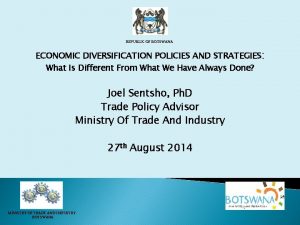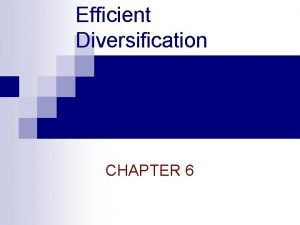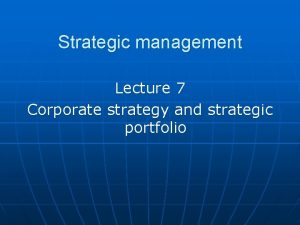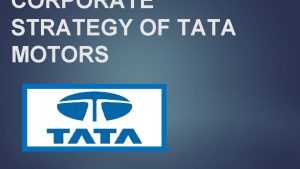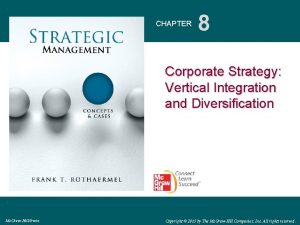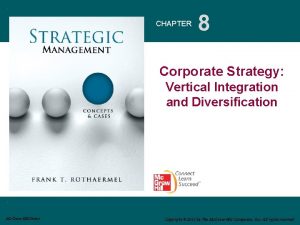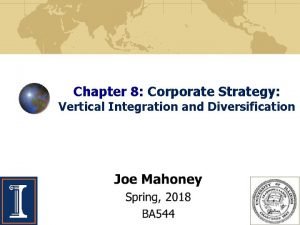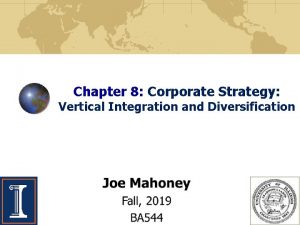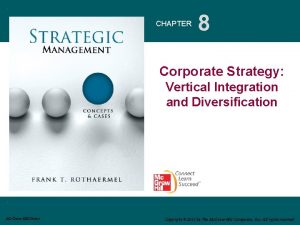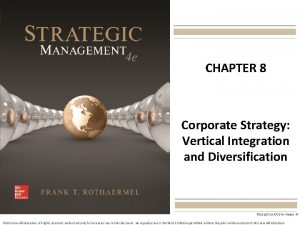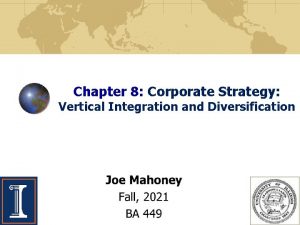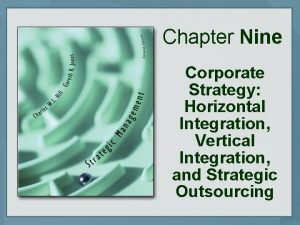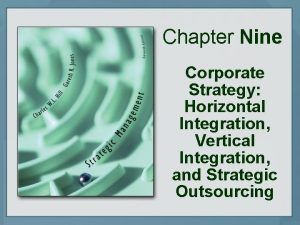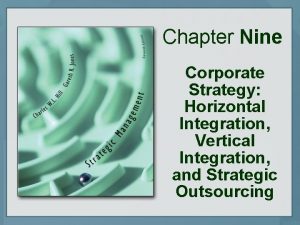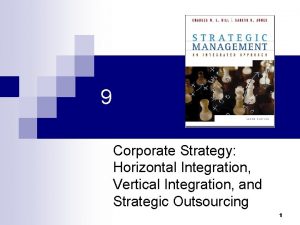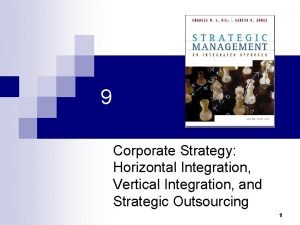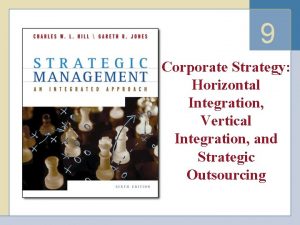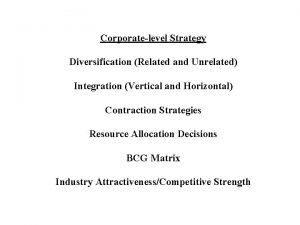CHAPTER 8 Corporate Strategy Vertical Integration and Diversification































- Slides: 31

CHAPTER 8 Corporate Strategy: Vertical Integration and Diversification Mc. Graw-Hill/Irwin Copyright © 2013 by The Mc. Graw-Hill Companies, Inc. All rights reserved.

What Is Corporate Strategy? • Corporate strategy Ø Quest for competitive advantage when competing in multiple industries v Ex: Jeffrey Immelt’s initiative in clean-tech and health care industries • Corporate strategy concerns the scope of the firm Ø Industry value chain Ø Products and services Ø Geography 7– 2 8 -2

What Is Corporate Strategy? (cont'd) • Economies of scale Ø Average per-unit cost decreases as its output increases v Ex: Anheuser-Busch Inbev largest global brewer • Economies of scope Ø Savings that come from producing more outputs or providing different services at less cost v Ex: Amazon range of products & services • Transaction cost Ø The cost associated with economic exchange v "Make or buy" decision 7– 3 8 -3

Firms vs. Markets: Make or Buy • Should a firm do things in-house (to make)? Or obtain externally (to buy)? • If Cin-house < Cmarket, then the firm should vertically integrate Ø Ex: Microsoft hires programmers to write code in-house rather than contracting out Ø Firms and markets have distinct advantages and disadvantages (see Exhibit 8. 2) 1– 4 8 -4

EXHIBIT 8. 2 Organizing Economic Activity: Firm vs. Markets 1– 5 8 -5

Firms vs. Markets: Make or Buy? • Disadvantage of “make” in-house Ø Principal – agent problem v owner = principal, manager = agent Ø Agent pursues his/her own interests • Disadvantage of “buy” from markets Ø Search cost Ø Opportunism Ø Incomplete contracting Ø Enforce legal contracts • Information asymmetries Ø One party is more informed than others v Akerlof – “Lemons problem” for used cars 1– 6 8 -6

Repurchasing • Pepsi. Co Ø Bottle distributors Ø Gain merchandising control • GM Ø Purchased a minority stake in Delphi Automotive LLC v Ensuring supply • Boeing Ø Aggressively outsources parts Ø Purchased a 50% stake in a joint venture that supplies parts for 787 Dreamliner jet (Worthen, B. , Tuna, C. , & Scheck, J. 2009) 1– 7 8 -7

EXHIBIT 8. 3 Alternatives along the Make or Buy Continuum 1– 8 8 -8

Vertical Integration along the Industry Value Chain • In what stages of the industry value chain should the firm participate? • Vertical integration Ø Ownership of its inputs, production, & outputs in the value chain Ø Horizontal value chain v Internal, firm-level value chains (Chapter 4) • Vertical value chain Ø Industry-level integration from upstream to downstream v Examples: cell phone industry value chain • Many different industries and firms 1– 9 8 -9

EXHIBIT 8. 4 Backward and Forward Vertical Integration along an Industry Value Chain 1– 10 8 -10

Types of Vertical Integration • Full vertical integration Ø Ex: Weyerhaeuser • Owns forests, mills, and distribution to retailers • Backward vertical integration Ø Ex: HTC’s backward integration into design of phones • Forward vertical integration Ø Ex: HTC’s forward integration into sales & branding • Not all industry value chain stages are equally profitable Ø Zara – primarily designs in-house & partners for speedy new fashions delivered to stores 1– 11 8 -11

EXHIBIT 8. 5 HTC’s Backward and Forward Integration along the Industry Value Chain in the Smartphone Industry 1– 12 8 -12

Benefits and Risks of Vertical Integration • Benefits of vertical integration Ø Securing critical supplies Ø Lowering costs Ø Improving quality Ø Facilitating scheduling and planning Ø Facilitating investments in specialized assets v Ex: HTC started as OEM & expanded to fully integrated 1– 13 8 -13

Strategic health system development • Vertical integration in managed health care Ø Shared information – improved quality & facilitating scheduling and planning Ø Hospital and Physician alliance against insurance companies - lowering costs Ø Specialists - Facilitating investments in specialized assets (Nauert, R. C. , 2002) 1– 14 8 -14

Risks of Vertical Integration • Increasing costs Ø Internal suppliers lose incentives to compete • Reducing quality Ø Single captured customer can slow experience effects • Reducing flexibility Ø Slow to respond to changes in technology or demand • Increasing the potential for legal repercussions Ø FTC carefully reviewed Pepsi plans to buy bottlers 1– 15 8 -15

Alternatives to Vertical Integration • Taper integration Ø Backward integrated but also relies on outside market firms for supplies OR Ø Forward integrated but also relies on outside market firms for some of its distribution • Strategic outsourcing Ø Moving value chain activities outside the firm's boundaries v Ex: EDS and People. Soft provide HR services to many firms that choose to outsource it. 8 -16

EXHIBIT 8. 6 Taper Integration along the Industry Value Chain Outside suppliers could also be off-shored when they are not located in the home country 8 -17

Corporate Diversification: Expanding Beyond a Single Market • Degrees of diversification Ø Range of products and services a firm should offer v Ex: Pepsi. Co also owns Lay's & Quaker Oats. • Diversification strategies: Ø Product diversification v Active in several different product categories Ø Geographic diversification v Active in several different countries Ø Product – market diversification v Active in a range of both product and countries 8 -18

Types of Corporate Diversification • Single business v Google • Dominant business v Microsoft • Related diversification Ø Related constrained v Exxon. Mobil Ø Related linked v Disney • Unrelated diversification v GE 8 -19

EXHIBIT 8. 7 Different Types of Diversification 8 -20

Richard Rumelt - UCLA • Business world – diversification is done to sustain top-line growth. • Companies begin thinking about diversification when growth has leveled-out and opportunities for expansion within their own business has subsided. (Lovallo & Mendonca, 2007) 7– 21

Leveraging Core Competencies for Corporate Diversification • Core competence Ø Unique skills and strengths Ø Allows firms to increase the value of product/service Ø Lowers the cost • Examples: Walmart – global supply chain v Infosys – low-cost global delivery system v • The core competence – market matrix Ø Provides guidance to executives on how to diversify in order to achieve continued growth 8 -22

EXHIBIT 8. 8 The Core Competence – Market Matrix Pepsi - Gatorade Bo. A - NCNB Salesforce. com Bo. A - Merrill Lynch 8 -23

Organizational Capabilities • Examples: marketing skill, distribution skills, human resources skill at top and middle management. Ø Heart of a companies value – firms seek businesses that are a good match for their capabilities. Ø Linked to diversification Ø When a business declines, should you liquidate your organizational capabilities or transfer them into a new business? (Matsusaka, 2001) 7– 24

EXHIBIT 8. 9 The Diversification-Performance Relationship 8 -25

Corporate Diversification • How does diversification enhance performance? Ø Economies of scale lower the cost Ø Economies of scope increase the value Ø Reduce cost and increase value simultaneously 8 -26

Corporate Diversification • Restructuring Ø Process of reorganizing and divesting business units Ø To refocus a company to leverage its core competencies • Boston Consulting Group growth-share matrix Ø Dogs Ø Cash cows Ø Stars Ø Question marks 8 -27

EXHIBIT 8. 11 BCG Matrix 8 -28

Corporate Diversification • Internal capital markets Ø Source of value creation in a diversification strategy Ø Allows conglomerate to do a more efficient job of allocating capital • Coordination cost Ø A function of number, size, and types of businesses linked to one another • Influence cost Ø Political maneuvering by managers to influence capital and resource allocation • Bandwagon effects Ø Firms copying moves of industry rivals 8 -29

Chapter Eight Conclusion • Corporate-level strategy • Options for firms to organize economic activity. . • Two types of vertical integration – backward and forward • Benefits and risks of vertical integration • Alternatives to vertical integration • Different types of corporate diversification • Core competence-market matrix for different diversification strategies. • Diversification strategy – competitive advantage or not 1– 30

References Lovalla, D. P. & Mendonca, L. T. (2007) Strategies strategist: An Interview with Richard Remult. Strategy, The Mc. Kinsey Quaterly, August 2007. Retrieved from http: //www. mckinsey. it/storage/first/uploadfile/attach/139924/file/stst 07. pdf Matsusaka, J. G. (2001). Corporate diversification, value maximization, and organizational capabilities. Journal of Business, 2001, 74 (3), 409 -431. Retrieved from http: //citeseerx. ist. psu. edu/viewdoc/download? doi=10. 1. 1. 122. 5464&rep=rep 1&type =pdf Nauert, R. C. (2002). Strategic health system development and managed care delivery. of Health Care Finance, 29(2), 5 -17. Retrieved from http: //search. proquest. com/docview/235180431? accountid=28644 Journal Worthen, B. , Tuna, C. , & Scheck, J. (2009, Nov 30). Companies more prone to go 'vertical'. Wall Street Journal. Retrieved from http: //search. proquest. com/docview/399140920? accountid=28644 1– 31
 Corporate strategy vs business strategy
Corporate strategy vs business strategy What is vertically integrated company
What is vertically integrated company Strategy formulation corporate strategy
Strategy formulation corporate strategy Vertical integration
Vertical integration Samsung unrelated diversification strategy
Samsung unrelated diversification strategy Diversified companies
Diversified companies Economic diversification drive strategy botswana
Economic diversification drive strategy botswana Volkswagen grouo
Volkswagen grouo Retrenching to a narrower diversification base:
Retrenching to a narrower diversification base: Goal of corporate finance
Goal of corporate finance Dominant capital allocation line
Dominant capital allocation line Three dimensions of corporate strategy
Three dimensions of corporate strategy Integration
Integration Define horizontal integration
Define horizontal integration Vertical and horizontal integration worksheet
Vertical and horizontal integration worksheet Related and unrelated diversification
Related and unrelated diversification Intensive integrative and diversification growth strategies
Intensive integrative and diversification growth strategies Related and unrelated diversification
Related and unrelated diversification Intensive integrative and diversification growth strategies
Intensive integrative and diversification growth strategies Organizational strategy types
Organizational strategy types What is corporate strategy in strategic management
What is corporate strategy in strategic management Ebusiness strategy
Ebusiness strategy What is corporate scope
What is corporate scope Strategy map hr scorecard digital dashboard
Strategy map hr scorecard digital dashboard 5 dimensions of diversification
5 dimensions of diversification Business strategy of tata motors
Business strategy of tata motors Corporate strategy triangle
Corporate strategy triangle A multidomestic corporate-level strategy is one in which:
A multidomestic corporate-level strategy is one in which: Corporate level cooperative strategy
Corporate level cooperative strategy Corporate level cooperative strategy
Corporate level cooperative strategy Corporate strategy
Corporate strategy Taper integration
Taper integration






